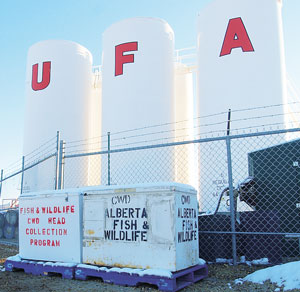Hunters in the Drumheller area are once again being asked to keep their heads.
For the second year in a row, Alberta Fish and Wildlife is asking hunters to submit the heads of any deer or elk they kill to a Wildlife Management Unit as part of the Chronic Wasting Disease (CWD) surveillance program.

Two freezers were recently dropped at the Drumheller UFA so that hunters may drop off their deer and elk heads for Chronic Wasting Disease (CWD) testing. Last year, Drumheller was added to the CWD surveillance area in response to the disease’s spread up the Red Deer River.
A freezer for submissions has been set up at the Drumheller UFA, 701 Railway Avenue.
“We need lymph nodes in the back of the throat and a very specific piece of the brain,” said Dr. Margo Pybus, a provincial wildlife disease specialist.
Hunters whose deer test positive for CWD will be contacted and given several options; they can keep the meat they harvested, discard the meat, or turn over all remains to Fish and Wildlife. The third option, turning everything over, will net the hunter a free license next year.
“We want hunters to keep hunting in the CWD areas, so we can continue to track the disease,” said Pybus. “We can’t do this without hunters and landowners providing access to hunters.”
Drumheller was added to the region of mandatory submissions last year. CWD has slowly been spreading westward up the Red Deer, South Saskatchewan, and Battle Rivers. The most westerly case, according to Pybus, was found in Bassano.
CWD is a type of transmissible spongiform encephalopathy caused by prions, similar to mad cow disease. CWD is characterized by weight loss, decreased interactions with other animals, listlessness, lowering of the head, blank expression, repetitive walking in set patterns, smell of rotting meat, excessive salivation, and grinding teeth.
The disease is invariably fatal.
However, early stages can only be determined through testing lymph and brain tissue.
“The majority of cases we find in Alberta are in the very early stages, so the hunters I’ve spoken with very rarely see any signs of the disease. Some hunters were surprised, because their deer looked perfectly healthy and had good fat content,” said Pybus.
“Our only management tool at the moment is to limit the deer density, so you limit the deer-to-deer contact and opportunities for potential transmission. This is where hunters come in.”
The World Health Organization and Centre for Disease Control recommends people avoid eating an animal with any prion disease.
“We don’t tell hunters what to do, but we do tell them that the World Health Organization and Centre for Disease Control recommends that any animal that has a prion disease, which includes CWD, not be eaten. Though the decision is ultimately up to the hunter,” said Pybus.